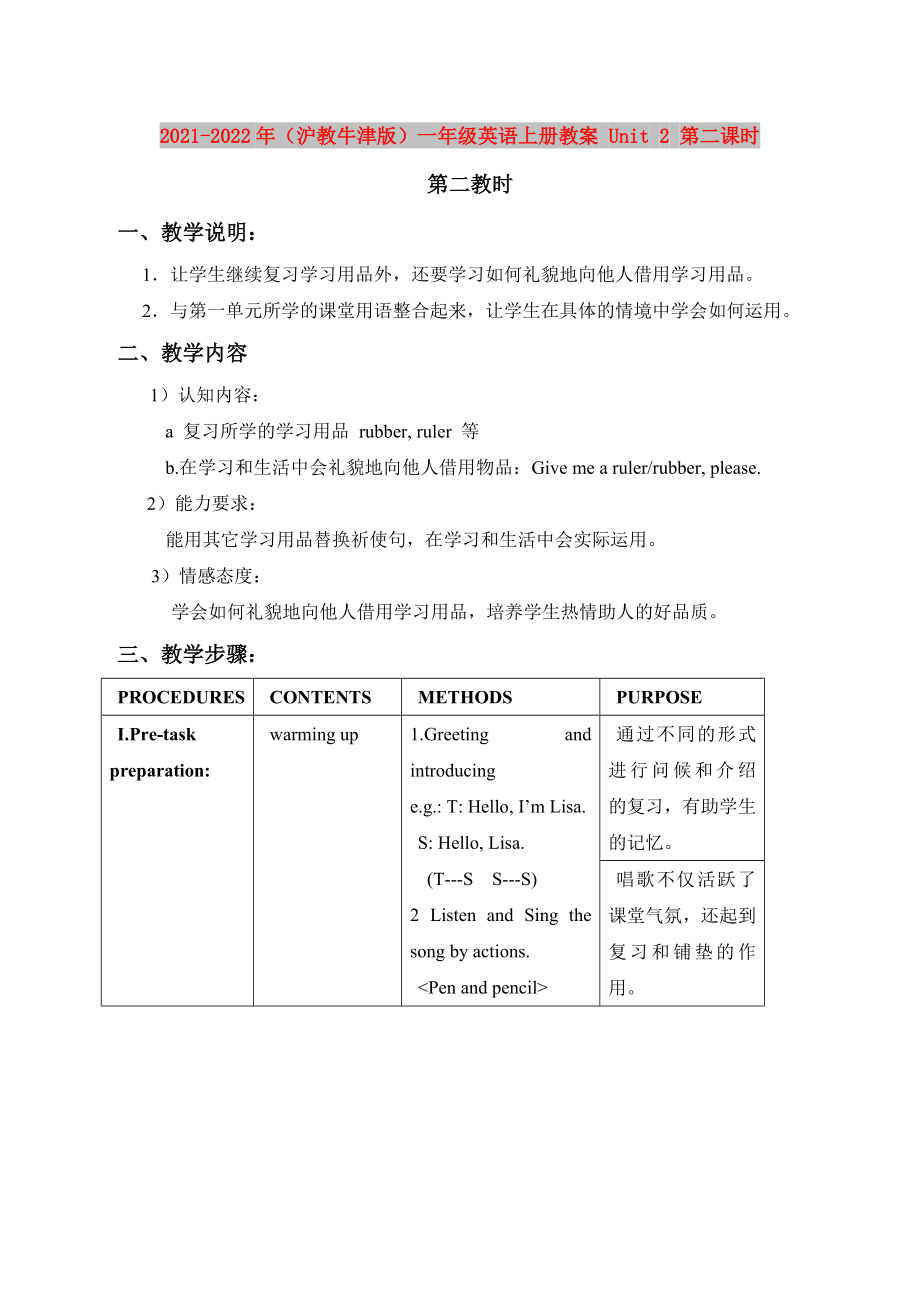《2021-2022年(滬教牛津版)一年級(jí)英語(yǔ)上冊(cè)教案 Unit 2 第二課時(shí)》由會(huì)員分享�,可在線閱讀,更多相關(guān)《2021-2022年(滬教牛津版)一年級(jí)英語(yǔ)上冊(cè)教案 Unit 2 第二課時(shí)(8頁(yè)珍藏版)》請(qǐng)?jiān)谘b配圖網(wǎng)上搜索�����。
1、2021-2022年(滬教牛津版)一年級(jí)英語(yǔ)上冊(cè)教案 Unit 2 第二課時(shí)
第二教時(shí)
一��、教學(xué)說(shuō)明:
1.讓學(xué)生繼續(xù)復(fù)習(xí)學(xué)習(xí)用品外�,還要學(xué)習(xí)如何禮貌地向他人借用學(xué)習(xí)用品。
2.與第一單元所學(xué)的課堂用語(yǔ)整合起來(lái)�����,讓學(xué)生在具體的情境中學(xué)會(huì)如何運(yùn)用����。
二、教學(xué)內(nèi)容
1)認(rèn)知內(nèi)容:
a 復(fù)習(xí)所學(xué)的學(xué)習(xí)用品 rubber, ruler 等
b.在學(xué)習(xí)和生活中會(huì)禮貌地向他人借用物品:Give me a ruler/rubber, please.
2)能力要求:
能用其它學(xué)習(xí)用品替換祈使句�����,在學(xué)習(xí)和生活中會(huì)實(shí)際運(yùn)用�����。
3)情感態(tài)度:
學(xué)會(huì)如何禮貌地向他人借
2���、用學(xué)習(xí)用品�,培養(yǎng)學(xué)生熱情助人的好品質(zhì)。
三�、教學(xué)步驟:
PROCEDURES
CONTENTS
METHODS
PURPOSE
I.Pre-task preparation:
warming up
1.Greeting and introducing
e.g.: T: Hello, I’m Lisa.
S: Hello, Lisa.
(T---S S---S)
2 Listen and Sing the song by actions.
通過(guò)不同的形式進(jìn)行問(wèn)候和介紹的復(fù)習(xí),有助學(xué)生的記憶�����。
唱歌不僅活躍了課堂氣氛�����,還起到
3��、復(fù)習(xí)和鋪墊的作用�。
II.While-task procedure:
1 Sentences teaching:
Give me a rubber/ ruler, please.
1 Let the children say the stationeries in the song .Teacher shows the word cards.
2 Show the box full with stationeries, let a student
play a game with you.
T: a rubber, please.
S : (
4�、take a rubber out)
T: Give me a rubber, please.
S: (give it to the teacher)
3 Read the sentence and do the action.
T---S S----S
4 Put up the chart and make a situation
eg:T: Sam and his classmates are drawing.
But he hasn’t got a rubber.
.What does he say to the girl?( Give me a rubber,
5、please.’ )
5 Let children be polite . Let them say
‘ Here you are.’ ‘Thank you.’
6 Let students act the dialogue between Ann and Tom.
通過(guò)師生之間的游戲引出新知��,激發(fā)學(xué)生的學(xué)習(xí)興趣���。
讓學(xué)生在情境中學(xué)習(xí)知識(shí)�����,便于學(xué)生理解和掌握����。
這些禮貌用語(yǔ)根據(jù)本學(xué)生的實(shí)際情況進(jìn)行教授
2 Consolidation
1.Follow the tape by the actions.
6、
2 Students act it in pairs.
跟讀錄音����,小組之間進(jìn)行操練,有助于糾正學(xué)生的發(fā)音
III.Post-task activity:
Making a dialogue.
1 Hold up different stationeries to let Students make new sentences.
2 Encourage students act out a dialogue in small groups
在和同學(xué)表演的過(guò)程中培養(yǎng)了學(xué)生的合作精神和創(chuàng)造能力���。
V. Assignment:
Listening�����,speaking a
7���、nd reading.
1.Listen and read after the tape on Page 7.
2 Make a dialogue with your friend.
模仿錄音的語(yǔ)音語(yǔ)調(diào)是必不可少的,讓學(xué)生在與朋友的交流中鞏固所學(xué)的知識(shí)�����,還能增進(jìn)感情��。
四�、教學(xué)提示:
1.媒體準(zhǔn)備:
掛圖,單詞卡片����,錄音機(jī)�,盒子和學(xué)習(xí)用品的實(shí)物等
2.教學(xué)關(guān)注點(diǎn):
1)關(guān)注學(xué)生對(duì)于某些單詞的發(fā)音����,特別是 ‘give’, ‘ me’ ‘please’ 的發(fā)音。
2)通過(guò)學(xué)生感興趣的活動(dòng)����, 讓他們?cè)诨顒?dòng)中用英語(yǔ)和他人交流���,提高語(yǔ)言的運(yùn)用能力���。
3.資料分享:
在小博士唱歌學(xué)英
8、語(yǔ)中有一首歌 ‘Pen and pencil ‘, 讓學(xué)生聽(tīng)唱��,可以鞏固所學(xué)知識(shí)�,還可以拓展新知。
4.設(shè)計(jì)思路:
1) 由歌曲和游戲引出所學(xué)內(nèi)容���,激發(fā)學(xué)生的學(xué)習(xí)興趣��,通過(guò)情境教學(xué)鞏固所學(xué)內(nèi)容���。
2) 在情境中穿插其它知識(shí)�,例如pencil-box, Here you are, Thank you.等單詞和句子的教授����,起到了拓展的作用。
附送:
2021-2022年(滬教牛津版)一年級(jí)英語(yǔ)上冊(cè)教案 Unit 3 第二課時(shí)
一�����、教學(xué)說(shuō)明:
1. 學(xué)生的學(xué)習(xí)積極性在教師有聲色的英語(yǔ)教學(xué)活動(dòng)中明顯調(diào)動(dòng)起來(lái)了���。
2. 學(xué)生已在Unit 1的兒歌里初步學(xué)習(xí)了I can…的句
9��、式��。
3. 本課重點(diǎn)教sing 這個(gè)詞�,draw, read 教師偏重于學(xué)生自學(xué)�����。
二��、教學(xué)內(nèi)容
1)認(rèn)知內(nèi)容:
a單詞sing, read, draw, 達(dá)到“三會(huì)”要求��。
b能流利表演歌曲。
c能用I can … 表達(dá)自己的能力�����。
2)能力要求:
能用一些名詞如:a song 等把自己的能力描述得更清晰����。
3)情感態(tài)度:
能在唱歌的過(guò)程中體驗(yàn)學(xué)習(xí)英語(yǔ)的快樂(lè), 同時(shí)要相信自己非常行�����。
三�����、教學(xué)步驟:
PROCEDURES
CONTENTS
METHODS
PURPOSE
I.Pre-task preparation:
warming up
10���、
1. Say some rhymes
2. Do some quick response
eg: Hi!,
How are you?
How old are you?
3.Listen to a song on page16,try to understand the meaning by teacher’s presentation.
可朗誦一些學(xué)生在以前的課堂中根據(jù)課文兒歌自己創(chuàng)編的兒歌,給學(xué)生成功的體驗(yàn)經(jīng)歷����,更能調(diào)動(dòng)學(xué)生學(xué)習(xí)英語(yǔ)的積極性。
通過(guò)快速應(yīng)答的方式來(lái)鞏固舊知識(shí)����,可以快速的把學(xué)生帶到英語(yǔ)學(xué)習(xí)的氛圍中
11����、來(lái)��。
學(xué)生在聆聽(tīng)中感知歌曲的旋律和歌詞的大意�,為進(jìn)一步學(xué)習(xí)本課單詞和歌曲作好準(zhǔn)備。
II.While-task procedure:
mands teaching:
sing, draw, read
1.Teacher sings the song and ask :What can I do? Then answer by himself ”I can sing.”
2. Students look at the pictures, word cards and read the word.
3. Stu
12���、dents repeat the word, phrase, rhyme after teacher.
eg: A. sing song
B. sing a song
C. sing, sing
I can sing.
sing, sing
I can sing a song.
4. Students practice the rhyme with their partners.
5. Teacher act the other two new words and show the cards.
6.Encourage students make some
13��、new phrases and small rhymes by using the new words.
eg: draw, draw
I can draw a book.
7. Students try to match the pictures and new word cards.
8. A guessing game
Student 1 acts the new word by using his voice, the other students back to S1 and guess what can he do.
用教師的動(dòng)作形象地引出單詞���。
14、
注意圖����、詞的呈現(xiàn),讓學(xué)生能音�����、形�����、圖(意)統(tǒng)一起來(lái)。
教師示范用單詞來(lái)造詞組��、句子��,為學(xué)生接下去自己學(xué)習(xí)鞏固后兩個(gè)新詞打下基礎(chǔ)��。
學(xué)生在通過(guò)模仿的基礎(chǔ)上自己進(jìn)行創(chuàng)編��,來(lái)學(xué)習(xí)并鞏固draw和?read �。學(xué)習(xí)最終的目的是讓學(xué)生在學(xué)習(xí)的過(guò)程中學(xué)會(huì)學(xué)習(xí)的方法。并在以后的學(xué)習(xí)中學(xué)會(huì)使用這些方法����。
Let’s learn中的單詞可通過(guò)各種有趣的游戲方法進(jìn)行鞏固。
學(xué)習(xí)動(dòng)詞不一定就是做動(dòng)作, 可以探索更多的感官來(lái)感受動(dòng)詞,這里就是聽(tīng)聲音來(lái)猜動(dòng)作����。
Song
1. Listen to the song on page 16 twice.
15�、
2. Encourage students try to sing the song after the tape.
III.Post-task activity:
Making a new song
Encourage students act out the song in pairs or small groups by using the other words. eg: bag, pencil, see…
在創(chuàng)編新歌中學(xué)生的創(chuàng)造能力和合作精神都得到了鍛煉。
V. Assignment:
Listening�,speaking and reading.
1.
16、.listen to the tape on page14
2. Read the new words.
3.Sing the new song to their family
Let’s learn部分的單詞���,要讓學(xué)生在不斷地認(rèn)讀中鞏固����。
四、教學(xué)提示:
1.媒體準(zhǔn)備:
單詞卡片�����, 圖片�����,錄音機(jī)
2.教學(xué)關(guān)注點(diǎn):
1)Let’s learn 中的單詞要關(guān)注其音���、形����、圖的配對(duì)統(tǒng)一�����,可運(yùn)用多種游戲的方法去鞏固�,降低遺忘的概率。
2)教學(xué)中應(yīng)關(guān)注讓學(xué)生學(xué)會(huì)學(xué)習(xí)的方法,體現(xiàn)從扶到放的原則���。并能讓學(xué)生在以后的學(xué)習(xí)中學(xué)會(huì)使用這些學(xué)習(xí)的方法�����。
3)關(guān)注兒童在教學(xué)活動(dòng)中的發(fā)散性思維的培養(yǎng)����。
3.資料分享:
4.設(shè)計(jì)思路:
1)將page14的六個(gè)單詞中的三個(gè)�,sing, read, draw 先教,因?yàn)榭梢耘浜蟨age17的歌曲進(jìn)行鞏固性操練�。
2)充分讓學(xué)生融入學(xué)習(xí)氛圍中,在學(xué)習(xí)新知識(shí)時(shí)學(xué)會(huì)學(xué)習(xí)的方法���。用學(xué)到的方法去解決以后學(xué)習(xí)中碰到的新問(wèn)題��。
5.教學(xué)反思:
學(xué)習(xí)動(dòng)詞不一定是做動(dòng)作��,可以探索更多的感官來(lái)感受動(dòng)詞�����。比如,用耳朵聽(tīng)來(lái)感受動(dòng)詞。通過(guò)這種反常理的感官來(lái)感受�,可以調(diào)動(dòng)學(xué)生學(xué)習(xí)的積極性,學(xué)習(xí)效果也比較理想��。
 2021-2022年(滬教牛津版)一年級(jí)英語(yǔ)上冊(cè)教案 Unit 2 第二課時(shí)
2021-2022年(滬教牛津版)一年級(jí)英語(yǔ)上冊(cè)教案 Unit 2 第二課時(shí)

